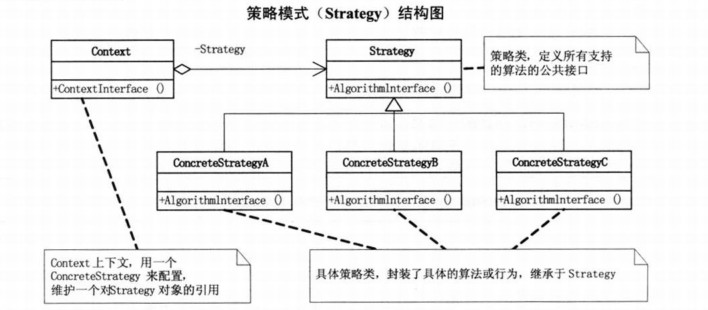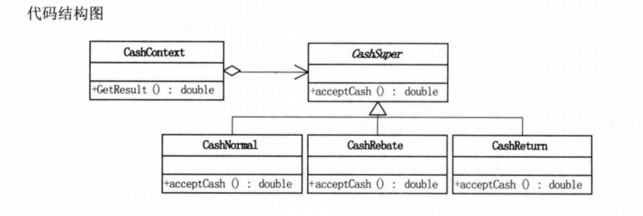一、一些基本定义和常识 Strategy['strætədʒɪ]n.
策略模式定义了一系列的算法,并将每一个算法封装起来,而且使它们还可以相互替换。策略模式让算法独立于使用它的客户而独立变化。此模式让算法的变化,不会影响到使用算法的客户。

二、策略模式的实现
using System; using System.Collections.Generic; using System.Linq; using System.Web; using Web.策略模式; namespace Web._1策略模式 { /// <summary> /// Strategy类,定义所有支持的算法公共接口 /// </summary> public class Strategy { /// <summary> /// 算法方法 /// </summary> public abstract void AlgorithmInterface();//['ælɡərɪðəm] n. 运算法则;演算法;计算程序 } /// <summary> /// 算法A /// </summary> internal class ConcreteStrategyA : Strategy { /// <summary> /// 算法A的实现 /// </summary> public override void AlgorithmInterface() { throw new NotImplementedException(); } } /// <summary> /// 算法B /// </summary> internal class ConcreteStrategyB : Strategy { /// <summary> /// 算法B的实现 /// </summary> public override void AlgorithmInterface() { throw new NotImplementedException(); } } internal class Context { private Strategy strategy; /// <summary> /// 初始化传入具体的策略对象 /// </summary> /// <param name="strategy"></param> public Context(Strategy strategy) { this.strategy = strategy; } /// <summary> /// 上下文接口 /// 根据具体的策略对象调用其算法的方法 /// </summary> public void ContextInterface() { strategy.AlgorithmInterface(); } } /// <summary> /// 客户端 /// /// </summary> class Customer { private static void Main(string[] args) { Context context; //由于实例化不同的策略,所以最终调用的ContextInterface()结果也是不同的 context=new Context(new ConcreteStrategyA()); context.ContextInterface(); context = new Context(new ConcreteStrategyB()); context.ContextInterface(); } } }
三、简单工厂问题的解决

internal class CashContext { private CashSuper cs; public CashContext(string type) { switch (type) { case "正常收费": CashNoraml cash0 = new CashNoraml(); cs = cash0; break; case "满300返100": CashReturn cash1 = new CashReturn("300", "100"); cs = cash1; break; case "打折:85折": CashRebate cash2 = new CashRebate("0.85"); cs = cash2; break; } } public double GetResult(double money) { return cs.AcceptCash(money); } } /// <summary> /// 客户端 /// </summary> internal class Customer { public void Method() { CashContext cc = new CashContext("type"); cc.GetResult(100d); } }
二者的区别:
简单工厂模式
/// <summary> /// 客户端实现 /// </summary> class Customer { public void Method() { CashSuper cash = CashFactory.CreateCashSuper("type"); cash.AcceptCash(100); } }
策略模式和简单工厂模式
/// <summary> /// 客户端 /// </summary> internal class Customer { public void Method() { CashContext cc = new CashContext("type"); cc.GetResult(100d); } }
简单工厂需识别两个类:CashSuper、CashFatory而策略模式和简单工厂结合的方法只有CashContext,降低了耦合度。
总结:
1、策略模式的Strategy类层次为Context定义了一系列的可供重用的算法和行为,继承有助于吸取出这些算法的公共功能。
2、策略模式的优点简化了单元测试,因为每个算法都有自己的类,可以通过自己的接口单独测试。
3、在基本的策略模式中,选择所用具体实现的职责由客户端对象承担,并转给策略模式的Context对象